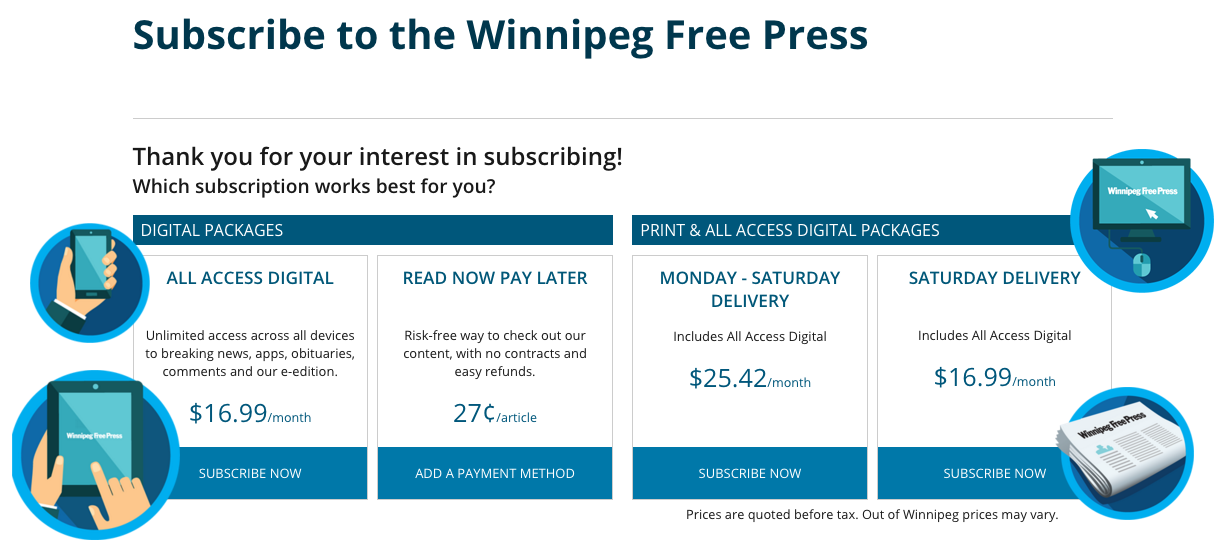Winnipeg Free Press sees success after one year of micropayments says publisher
35,000 people have signed up for the Free Press’s digital content in the last year according to publisher Bob Cox.
This story was funded by the J-Source Patreon campaign.
By Jessica Patterson
A year after introducing its micropayment system, the Winnipeg Free Press has 35,000 subscribers for its digital content, according to Publisher Bob Cox.
Cox gave a seven-minute update on the paper’s micropayment experiment at the Newspapers Canada 2016 National Conference in Edmonton on May 27.
He said the Free Press currently has 200,000 registered accounts, 35,000 paid digital readers, 27,000 of which are also print subscribers, and the remaining 8,500 are read-now-pay-later subscribers or all-access-digital subscribers. It sells approximately 1,000 articles a day, on a per-article-basis. Since it launched the micropayment model July 1, 2015, the Free Press has had 265,000 articles purchased.
Last year, the Winnipeg Free Press was the first in Canada to monetize its content via micropayments, something it called a “pick-and-pay model.” It works by offering its audience three articles for free each month. After that, they must pay for the stories they read, piece by piece. Readers are billed each month for the articles they purchase. If they’d rather subscribe, an all-access digital pass costs $16.99 per month.
When the Free Press announced its ambitious strategy last year, its goal was to build an engaged audience, selling them stories at 27 cents each. Micropayments was only part of its monetization strategy, which also involved subscriptions, single copy sales and advertising.
“It would never work on its own. One article at a time isn’t going to keep your paper alive. It’s part of our strategy to build our subscriber base and an engaged audience,” Cox said.
Paywall isn’t a term that Cox is comfortable using. “From a micropayment point of view, we opened a door. Our hope is that we can keep that door open and enrich that relationship with them.” According to him, 15 percent of all micropayment users convert to all access subscriptions.
However, the Free Press’s micropayment revenue strategy encountered challenges. According to Cox the paper had a problem with advertisers who feared a decline in the newspaper’s audience. The Free Press had to counter that with education.
“There was this perception that there was a barrier there,” Cox said. “The only thing is, though, that we actually had lots of space for them, we still had lots of premium advertising space for our local advertisers.”
The move boosted the Free Press’s circulation a little bit, Cox said. All-access digital subscribers were offered the Saturday print edition with their digital package.
“A lot of people take us up on that offer,” he said. “So, they get the Saturday paper in print and they get all access digital, and we’ve been able to convert a number of those people to start taking the Saturday printed paper, so there’s been a little bit of a boost. It’s not a lot, but there’s been a little bit of a boost.”
However, as a result of the shift to micropayments, the Free Press’s digital subscriptions increased in the last year. “This is the first year in my memory that we can say that we have gone up in terms of paid subscriptions and I think it’s because of this system we’ve introduced. We wanted to have doors and windows in there.”
It offers a refund if users click on an article they didn’t want, accidentally came to an article, or are angry about an article.
“The main reason is good customer service. Any business that can’t give consumers an out, isn’t a very good business,” Cox said. “Our refund policy is just good business sense. For that reason, we allow them to opt out of paying for it.”
Over the 12-month period that the micropayment strategy has been in operation, the Winnipeg Free Press did 2,531 refunds, or less than one per cent.
Using micropayments has given the Winnipeg Free Press better opportunities to reach people, Cox explained. “Through our relationships with them, we know who they are and we can market to them.”
Through this micropayment experiment, the Winnipeg Free Press has also discovered that its digital audience is more engaged than it used to be, Cox said.
“What we found, was the paid digital audience is a lot more engaged, they spend more time on the site, they spend more time with each article, so they’re a better audience for advertisers,” Cox said.
Correction: a previous version of this story contained a typo that indicated there were 3,500 digital readers rather than 35,000. This version has been updated. We apologize for the error.

